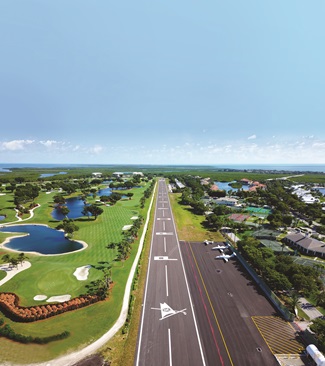There was no flight plan filed, just a phone call home 32 years ago from an island in the Bahamas, the last words Steve Harrison’s family ever heard from him. Flying a rented Cessna 310 (his own was in the shop), Harrison told his wife he had one more stop to make before departing the following day from Eleuthera Island to return home to Greensboro, N.C.
This year, a television production crew recruited retired U.S. Marine Corps Col. Peter B. Field, an aviator with a distinguished career including service as director of the U.S. Naval Test Pilot School, to join a search for the missing aircraft in the shallow waters surrounding the Bahamas. Field, who now works as a consultant and expert witness on aviation, was at first reluctant to participate in a show that aimed to explore both the mythology and facts of the Bermuda Triangle for a show that will air Oct. 14 on the Discovery Channel, an installment in the Curiosity series.
“I don’t believe anything about the Bermuda Triangle,” Field said. Still, Pam Harrison’s search for her father, lost when she was 18, was compelling, and Field agreed to assist in an underwater search of promising aircraft wrecks. Divers, briefed by Field on what to look for and where, photographed a pair of aircraft wrecks, seeking serial numbers or registration markings. Wreckage sunk for 30 years in those waters is difficult to recognize, and Field ruled out one wreck based on subtle differences in the shape of the cowling.
On a second wreck, a mystery was solved, though not with the answer they sought: a serial number on a badly-decayed Lycoming engine was traced, with Lycoming’s help, to a Piper lost long ago on a trip from Puerto Rico to the mainland, found in the waters off of Bimini—a pair of small islands located 45 nm east of Miami Beach.
Field said the islanders who took part in the search were convinced there was more to the story than airplanes getting lost in the usual ways.
“They’re a superstitious crowd down there,” Field said. “They’re still firmly in the belief that there’s some sort of a badness down there that grabs airplanes.”
The television crew pressed Field to explain why so many aircraft wrecks were scattered in those waters.
“I had to tell them … airports attract airplanes, and crashes happen around airports for that reason,” Field said, adding that ordinary weather and pilot error are the most plausible explanations, generally, for the disappearances often attributed to unknown forces in the Bermuda Triangle.
Field is not sure how much of his commentary will make it into the show.
“I have flown through the Bermuda Triangle a number of times,” Field said of his 27-year military career. “We never thought a thing about it … I know it’s a great story.”
Field also briefed the producers on the 1945 loss of a flight of five TBM Avengers that left Florida on a practice bombing mission near Bimini. Unlike Harrison’s 1980 disappearance, the disappearance of the Marine Corps flight has been well-studied, and documented to the extent possible absent any trace of the missing aviators.
Field said clouds can easily obscure islands, or fool pilots into mistaking them for other islands. Thunderstorms are very common, and their electrical discharges can make wet compasses swing wildly. It is plausible that the Marines, four of them trainees, mistook the Bahamas for the Florida Keys and headed east when they should have headed west, realizing their mistake too late, if at all.
“It wouldn’t be hard to convince yourself that you’d seen something that looked like the Keys,” Field said.
Whatever caused Harrison’s loss, Field still hopes to find the wreckage of N360BU. He said Harrison’s daughter’s plight struck a chord, and the family is also offering a $20,000 reward to anyone who can find the missing aircraft—and with it, presumably, Steve Harrison’s final resting place. Field has now secured his own scuba certification, and plans to search himself, though it will be a longshot: There’s no way to know for sure what airport Harrison might have departed from, or even what island. His chosen route is likewise unknown.
“I’m thinking about going down with one of my boys,” Field said. It will be educated guesswork, at best. “You just have to figure in your own mind what could have gone wrong.”
Deadly Lightning Strike | Curiosity: The Devil's Triangle



